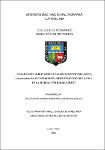Mostrar el registro sencillo del ítem
Evaluación agronómica y valor nutritivo de avena (Avena sativa) bajo condiciones de restricción de lluvia en la sierra central del Perú
| dc.contributor.advisor | Gómez Bravo, Carlos Alfredo | |
| dc.contributor.author | Arango Quispe, Sheyla Johanna Shumyko | |
| dc.date.accessioned | 2019-11-25T19:21:45Z | |
| dc.date.available | 2019-11-25T19:21:45Z | |
| dc.date.issued | 2019 | |
| dc.identifier.other | F06.AR662 - T BAN UNALM | |
| dc.identifier.uri | https://hdl.handle.net/20.500.12996/4207 | |
| dc.description | Universidad Nacional Agraria La Molina. Escuela de Posgrado. Maestría en Nutrición | es_PE |
| dc.description.abstract | La escasez de agua provocada por el cambio climático afecta el desarrollo de la avena forrajera en la Sierra Central del Perú. Los estudios que simulen escenarios futuros de sequía son importantes debido a que este recurso comienza a ser cada vez más escaso y es por ello la necesidad de identificar los genotipos de Avena sativa resistentes a la sequía que mantengan rendimientos y calidad aceptables. El objetivo general de este estudio fue caracterizar de manera agronómica y en base a su valor nutritivo ocho genotipos de avena en respuesta a la restricción de lluvia. El presente estudio se realizó en Apata, departamento de Junín, donde se evaluaron en un diseño completamente al azar con arreglo factorial ocho genotipos de avena forrajera (INIA901 Mantaro 15, INIA902 Africana, INIA903 Tayco, Junin-Jauja blanca, Centenario, Junin-Tarma negra, Junín-Jauja negra y Cayuse) con 0 y 60 por ciento de restricción de lluvia y 3 repeticiones. Se tuvieron 48 unidades experimentales (parcela de 4.8 metros cuadrados), donde el 60% de restricción de lluvia se logró mediante la colocación de techos con canaletas de acrílico sobre una parcela. Se encontró a una confianza del 95% que no existe interacción entre los genotipos de avena y el porcentaje de restricción de lluvia; además, que la restricción de lluvia afecta significativamente el rendimiento disminuyéndolo y al porcentaje de proteína cruda aumentándolo. La altura de planta es una característica propia de cada genotipo de la avena ya que hay diferencias significativas entre ellas pero no se ve afectada significativamente por la restricción de lluvia. No se encontró un efecto significativo de la restricción de agua en los otros parámetros como la fibra detergente neutro y la digestiblidad in vitro aparente de la materia orgánica. Los genotipos que mejor resisten la sequía son la Junín-Jauja negra, procedente de Junín y la Centenario. | es_PE |
| dc.description.abstract | The scarcity of water caused by climate change affects the development of oat forage in the Peruvian highlands. Studies that simulate future drought scenarios are important because this resource is becoming increasingly scarce and that is why it is necessary to identify drought-resistant Avena sativa genotypes that maintain acceptable yields and nutritional quality. The general objective of this study was to characterize eight oat genotypes under rainfall restriction based on their agronomic characteristics and their nutritive value. This study was conducted in Apata, Junin where eight genotypes of forage oats (INIA901 Mantaro 15, INIA902 Africana, INIA903 Tayco, Junin-Jauja white, Centenario, Junin-Tarma dark, Junin-Jauja dark y Cayuse) under 0 and 60 percent rainfall restriction with 3 replicates each were evaluated in a completely randomized design with factorial arrangement. There were 48 experimental units (4.8 square meters) and the 60% of rainfall restriction was set up by putting a rain out shelter on the field. A 95% confidence test found the nonexistence of interaction between oat genotypes and the percentage of rainfall restriction. In addition, rainfall restriction decreases yield and increases the percentage of protein significantly. Plant height is a characteristic that belongs to the genotype because there were significant differences between them but this characteristic is not affected by the rainfall restriction itself. There was not found any significant effect among the other parameters such as neutral detergent fiber and aparent in vitro organic matter digestibility. The two genotypes with the best drought resistance were Junin-Jauja dark and Centenario. | en_US |
| dc.description.uri | Tesis | es_PE |
| dc.format | application/pdf | en_US |
| dc.language.iso | spa | es_PE |
| dc.publisher | Universidad Nacional Agraria La Molina | es_PE |
| dc.rights | info:eu-repo/semantics/openAccess | en_US |
| dc.rights.uri | https://creativecommons.org/licenses/by-nc-nd/4.0/ | * |
| dc.source | Universidad Nacional Agraria La Molina | es_PE |
| dc.source | Repositorio institucional - UNALM | es_PE |
| dc.subject | Avena | es_PE |
| dc.title | Evaluación agronómica y valor nutritivo de avena (Avena sativa) bajo condiciones de restricción de lluvia en la sierra central del Perú | es_PE |
| dc.type | info:eu-repo/semantics/masterThesis | en_US |
| thesis.degree.discipline | Nutrición | es_PE |
| thesis.degree.grantor | Universidad Nacional Agraria La Molina. Escuela de Posgrado | es_PE |
| thesis.degree.name | Magister Scientiae - Nutrición | es_PE |
| thesis.degree.level | Maestría | es_PE |
| dc.subject.ocde | https://purl.org/pe-repo/ocde/ford#1.06.10 | es_PE |
Ficheros en el ítem
Este ítem aparece en la(s) siguiente(s) colección(ones)
-
M-NUT Tesis [83]



